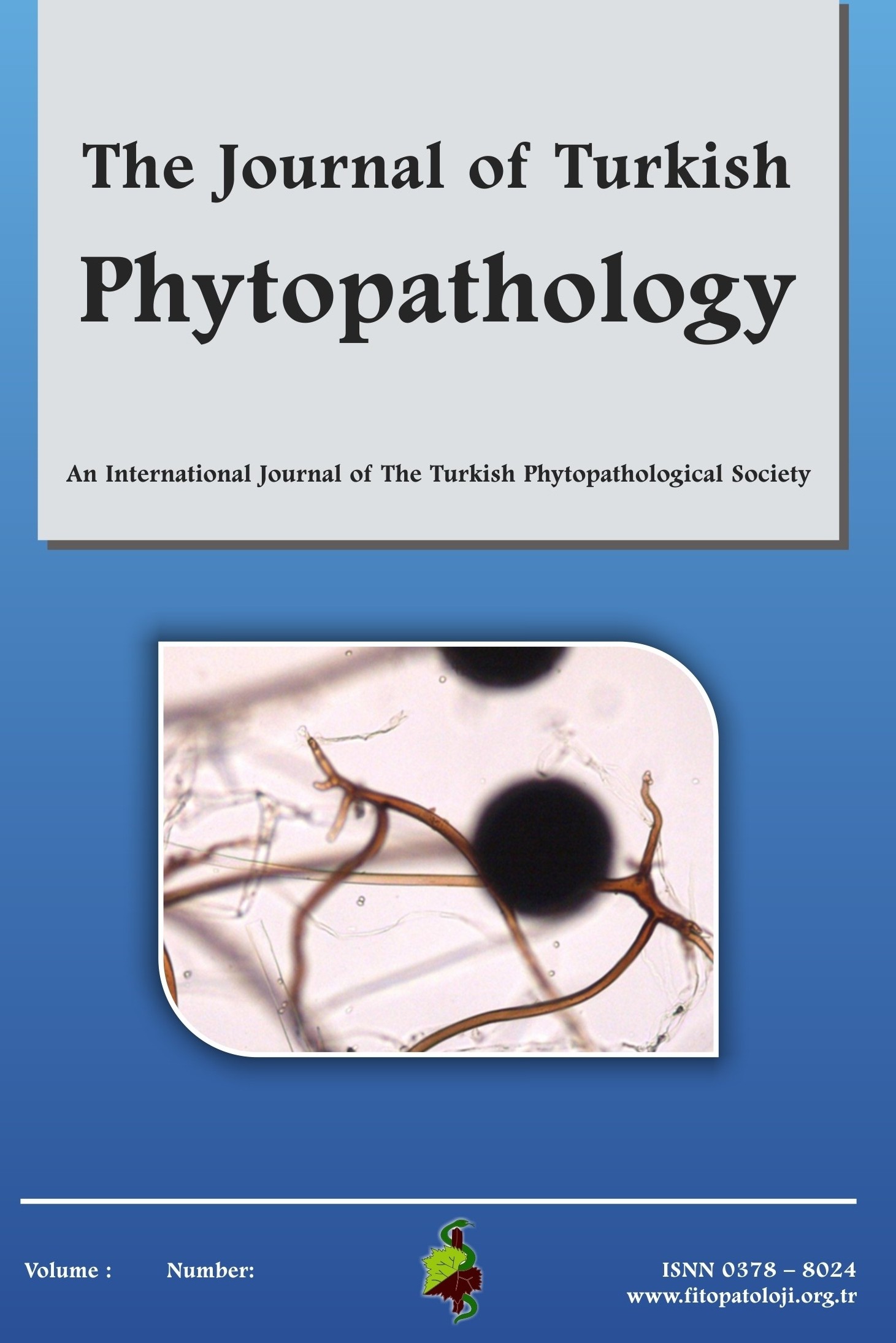Identification and Pathogenicitiy of Botryosphaeriaceae Species Causing Wood Canker on Grapevines
Identification and Pathogenicitiy of Botryosphaeriaceae Species Causing Wood Canker on Grapevines
Wood
canker and dieback diseases, caused by Botryosphaeriaceae fungi, are among the
most important fungal trunk diseases of grapevines. In recent years, the
symptoms of local dead arm, shoot dieback and V-shaped discolorations in woody
tissues have dramatically increased in vines of Turkey. During the 2012 growing
season, symptomatic wood samples (from Ankara, Çorum, Izmir, and Manisa cities)
were taken and standard mycological isolations were done to determine the
fungal agents of disease. A high proportion (69.4%) of Botryosphaeriaceae fungi
was isolated from these samples. In the first stage of the isolates’identification,
fungal DNA was extracted and amplified in Real-Time thermocycler by using the
genus spesific primers (BOT100F-BOT472R). In this way, the members of
Botryosphaeriaceae species were distinguished from other similar species. In
molecular identification of the isolates, ITS 1 and ITS 2 ribosomal DNA
fragments were sequenced and the gene sequences were compared with those
deposited in NCBI Gene Bank database.It has been determined that 4 different
species Botryosphaeria dothidea (Anamorph;
Fusicoccum aesculi), Diplodia seriata(An; B. obtusa) Lasiodiplodia theobromae (An; B.
rhodina) andNeofusicoccum parvum
(An; B. parva) were found in the
sequenced 15 isolates. Colony morphology on PDA media andpicniospore shapes on
woody tissues were examined in morphological / microscopic identification. To
fulfill Koch’s postulates, pathogenicity tests for all isolates were conducted
on 1-year-old potted vines. Four months after inoculation, the lesion lengths
on woody tissues were evaluated. Pathogenicity tests revealed that Neofusicoccum parvum species produced
larger lesions on woody tissues when compared to control and other species.
Keywords:
Botryosphaeriaceae, Grapevine, Trunk Diseases,
___
- Akgül, D.S., Savaş, N.G., and Eskalen, A. 2014. First report of wood canker caused by Botryosphaeria dothidea , Diplodia seriata, Neofusicoccum parvum, and Lasiodiplodia theobromae on grapevine in Turkey. Plant Disease: 98(4): 568p. Amponsah, N. T. 2010. Epidemiology of Botryosphaeriaceous species associated with grapevines in New Zealand. Lincoln University, PhD thesis, 251 p. Burruano S., V. Mondello, G. Conigliaro, A. Alfonso, A. Spagnoloand L. Mugnai, 2008. Grapevinedecline in ItalycausedbyLasiodiplodia theobromae. Phytopath¬ologia Mediterranea,47: 132–136. Cenis, J. L. 1992. Rapid extraction of fungal DNA for PCR amplification. Nucleic Acid Research, 20 (9): 2380p. Crous P.W., B. Slippers, M.J. Wingfield, J. Rheeder, W.F.O. Marasas, A.J.L. Phillips, A. Alves, T. Bur¬guess, P. Barberand J.Z. Groenewald, 2006. Phylo¬geneticlineages in theBotryosphaeriaceae. Studies in Mycology,55: 235–253. Evidente A., B. Punzo, A. Andolfi, A. Cimmino, D. Melckand J. Luque, 2010. Lipophilic phytotoxins producedby Neofusicoccum parvum, a grapevine canker agent. Phytopathologia Mediterranea,49: 74–79. Luque J., S. Martos, A. Aroca, R. Raposoand F. Garcia- Fihueres, 2009. Symptoms and fungi associated with declining mature grapevine plants in northeast Spain. Journal of Plant Pathology,91: 381–390. Martos S., A. Andolfi, J. Luque, L. Mugnai, G. Suricoand A. Evidente, 2008. Production of phytotoxic metabo¬lites by five species of Botryosphaeriaceae causing de¬cline on grapevines, with special interest in the spe¬cies Neofusicoccum luteum and N. parvum. European Journal of Plant Pathology,121: 451–461. Pitt, W. M.,Huang, R., Steel, C. C., Savocchia, S. 2010. Identification, distribution and current taxonomy of Botryosphaeriaceae species associated with grapevine decline in New South Wales and South Australia. Australian Journal of Grapeand Wine Research,16: 258–271. Ridgway, H.J.,Amponsah, N.T., Brown, D.S., Baskarathevan, J., Jones, E.E., and Jaspers, M.V. 2011. Detection of Botryosphaerious species in environmental samples using a multi-species primer pair. PlantPathology, 60: 1118–1127. Rolshausen P.E., L.C. Greve, J.M. Labavitch, N.E. Ma¬honey, R.J. Molyneux and W.D. Gubler, 2008. Patho¬genesis of Eutypalata in grapevine: Identification of virulence factors and biochemical characterization of cordon dieback. Phytopathology,98: 222–229. Siebert, J. B. 2001. Eutypa: The economic toll on vineyards. Wines Vines Apr:50-56. vanNiekerk J.M., P.W. Crous, J.Z. Groenewald, P.H. Fou¬rieand F. Halleen, 2004. DNA phylogeny, morphology and pathogenicity of Botryosphaeria species on grape¬vines. Mycologia,96: 781–798. Wilcox W.F., 2011. Disease Management. In: 2011 New York and Pennsylvania Pest Management Guidelines for Grapes (T.H. Weigleand A.J. Muza, ed.). Cornell University Cooperative Extension, Geneva, NY, USA and Pennsylvania State University, College of Agricul¬tural Sciences, State College, PA, USA. Online publi-cation: http://ipmguidelines.org/Grapes/ White, White TJ, Bruns T, Lee S, Taylor J. 1990. Amplification and direct sequencing of fungal ribosomal RNA genes for phylogenetics. In: Innis MA, Gelfand DH, Snisky JJ, White TJ, eds. PCR protocols: a guide to methods and applications. San Diego: Academic Press. p 315–322. Úrbez-Torres, J. R., Leavitt, G. M., Voegel, T. M., andGubler, W. D. 2006. Identification and distribution of Botryosphaeria spp. associated with grapevine cankers in California. Plant Disease, 90:1490-1503. Úrbez-Torres J.R. and W.D. Gubler, 2009. Pathogenicity of Botryosphaeriaceae species isolated from grapevine cankers in California. Plant Disease,93: 584–592. Urbez-Torres, J. R. 2011. The status of Botryosphaeriaceae species infecting grapevines. Phytopathologia Mediterranea, 50 (Supplement), S5−S45. Úrbez-Torres, J. R.,Peduto, F., Smith, R. J., andGubler, W. D. 2013. Phomopsis dieback: A grapevine trunk disease caused by Phomopsis viticola in California. Plant Disease, 97:1571-1579.
- ISSN: 0378-8024
- Yayın Aralığı: Yılda 3 Sayı
- Başlangıç: 1971
- Yayıncı: Türkiye Fitopatoloji Derneği
Sayıdaki Diğer Makaleler
Combination of Irradiation and Sodium Carbonate to Control Postharvest Penicillium Decay of Apples
Identification and Pathogenicitiy of Botryosphaeriaceae Species Causing Wood Canker on Grapevines
D. Soner AKGÜL, Nurdan GÜNGÖR SAVAŞ, Turcan TEKER
Studies on Esca and Petri Diseases in Grapevine Nurseries and Vineyards in Aegean Region
